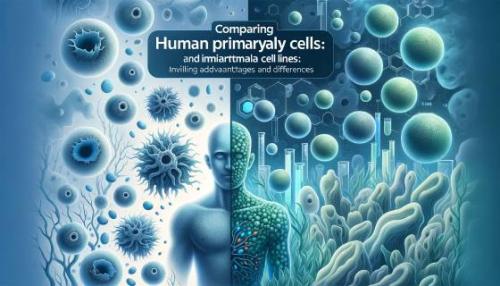Comparing Human Primary Cells and Immortal Cell Lines: Unveiling Advantages and Differences

In the realm of research and drug development, cell lines have become a widely used model for studying both healthy and diseased tissues. Their ease of handling, cost-effectiveness, and stability have made them an attractive choice. However, it is crucial to recognize that cell lines might not fully mirror the complexity of in vivo situations. For researchers aiming to model intricate physiological behaviour, human primary cells offer a more suitable option.
Imagine planting a flower garden where you have the choice of selecting expensive and high-maintenance flowers that perfectly fit your environment or opting for affordable varieties that grow everywhere but lack perfection. Similarly, when researchers must decide between primary cells and immortal cell lines for their projects, several factors come into play.
If your goal is to build a cell culture model that closely mimics human in vivo conditions, primary cells should be your preference. Additionally, for publishing results, validating them in a system relevant to human physiology is advisable. Conversely, if you seek a model that is convenient, well-established, and easy to work with, immortal cell lines are the preferred option, even though their behavior might not precisely resemble that of human cells.
Peeking into Real Life with Human Primary Cells
Human primary cells are directly isolated from tissues, retaining the morphological and functional characteristics of their tissue of origin. For instance, original tumour tissue from colorectal cancer preserves numerous tumour markers and known microRNAs, while cell lines display differences in their expression.
However, primary cells have a limited lifespan as they undergo senescence processes, self-renewal potential, and differentiation capabilities. It is best to use them in early passages to avoid morphological and functional changes that occur with ageing. The genetic characteristics and age of donors are also influential factors, as the cells' behaviour can vary under the same culture conditions. This variability can be useful when investigating cellular features across populations or testing new compounds. However, if low variance is required, using cells from the same donor is recommended.
Primary cells offer the advantage of obviating the need for animal models, minimizing inter-species differences that could impact drug toxicity and mode of action.
Handling Primary Cells with Care
Primary cell cultures can originate from healthy or cancerous cells, sourced from organ donations, surgical specimens, fetal tissues, or post-mortem donors. However, the limited availability of human primary cell sources means that obtaining extra material from the same donor might not be possible. Additionally, derived from tissue explants consist of a mix of different cells at different stages, necessitating the purification of specific cell types for more homogeneous cultures. Due to their sensitivity, human primary cells often require additional nutrients and growth factors for optimal growth.
It is crucial to optimize culture conditions for each cell type, as different cells have distinct media requirements. Notably, high variability of serum content can influence research results when using cell lines. High levels of antibiotics can also negatively affect the viability and growth of primary cells. To ensure quality control, thorough characterization of cells at different stages of culture is essential, and adherence to good cell culture practices, including comprehensive documentation, ensures model transparency and reproducibility.
Cell Lines: Vital Tools in Biological Research
The use of primary cells is built upon decades of research involving cell lines. Since the early 20th century, cell lines have provided valuable insights into the biological processes of human cells. Immortal cell lines serve as powerful tools for various applications, including drug metabolism and cytotoxicity testing, gene function studies, and the production of vaccines, antibodies, and biological compounds.
Choosing between primary cells and immortal cell lines depends on the research objectives. For investigations into basic biological processes, cellular function manipulation, new method establishment, or preliminary screenings, immortalized cell lines are favoured for their cost-effectiveness, ease of handling, and extended culture capabilities. Furthermore, high throughput screening can benefit the unlimited supply of material provided by cell lines.
However, it is essential to acknowledge that while experimental findings obtained from cell lines can be readily interpreted and compared, their physiological relevance may be limited. Serial passages can introduce genotype and phenotype variations, resulting in altered genomic content and abnormal expression profiles. Not possessing key morphological or functional features, cell lines might not induce relevant biomarkers. Consequently, findings from cell lines may not be directly translatable to human systems. Moreover, the prolonged use of immortal cell lines can lead to contamination by other cells or microorganisms, necessitating thorough validation to avoid misidentification or contamination.
In conclusion, the selection between primary cells and immortal cell lines should align with the research aim. Immortal cell lines serve as valuable models for preliminary experiments, while primary cells offer the opportunity to replicate and confirm key findings, enhancing the translational potential and relevance to human physiology.

Comments